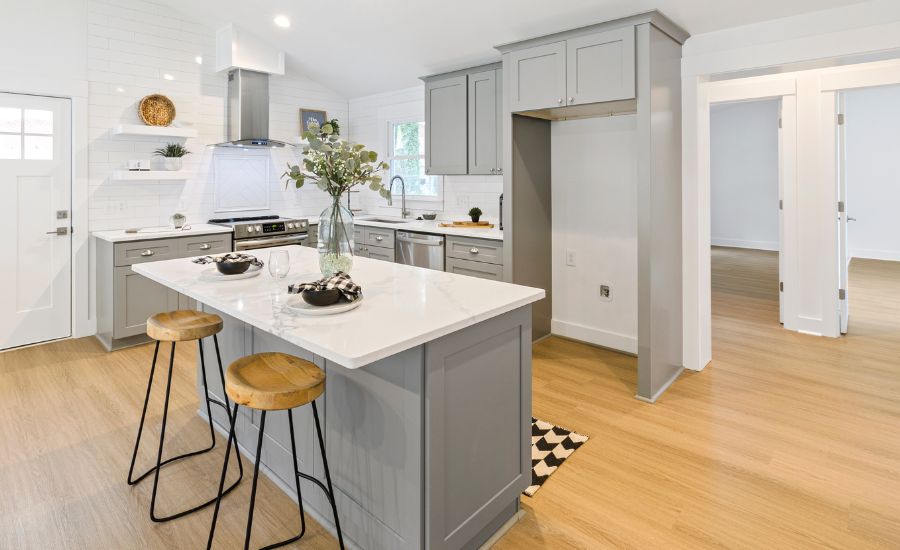How is a kitchen island attached to the floor? For easier food preparation and extra counter space (and storage space), we go into the crucial details of how island cabinets are attached to the floor surface in this in-depth explanation.
After reading this article, you’ll be equipped with the information and confidence necessary to have your kitchen island attached to the floor, resulting in stunning, useful, and safe kitchen islands.

Pre-installation kitchen islands’ considerations
Not all kitchen islands, like built-in islands, require a floor attachment; examples include mobile kitchen islands / movable kitchen islands.
There are a few critical pre-installation aspects to bear in mind to install a kitchen island properly before you begin the process of having your island cabinets attached to the floor.
Assessing your kitchen
You’ll lay a solid foundation for a kitchen island attached to the floor by carefully evaluating your kitchen.
Measuring available floor space for a kitchen island
Measure the space where you want to put your island cabinet before you do anything else.
Use a tape measure to precisely measure the length and width of the area needed for a kitchen island because accuracy is crucial here.

Considering traffic flow
Consider how traffic flows through your kitchen. Make sure there is sufficient space around the large island so that people may move about without difficulty, even when the secured kitchen island is in use.
Think about things like sitting layouts, cupboard and appliance access, and door swing.
If your kitchen is rather tiny, think about getting movable islands / portable islands.
Movable islands provide additional storage space for small appliances and necessary things while also serving as breakfast countertops or coffee stations.
Choosing the right kitchen island
You may confidently design and carry out the kitchen islands project with the help of these factors.
Size and style of kitchen islands
Your kitchen island and base cabinets’ dimensions and design, as well as the kitchen island’s design and functionality, should go together.
If your kitchen is roomy, you might choose a bigger kitchen island with extra features like a cooktop or sink.
A tiny kitchen island can add more workspace and storage without taking up too much room in smaller kitchens.

Materials and weight of kitchen islands
Think about the components that will be used to build the fixed kitchen islands.
In order to attach the built-in islands to heavier materials, such as granite or concrete, more durable attachment techniques are needed.
Make sure the weight of a kitchen island is appropriate for the strength of your kitchen floor and the way you’ve selected to attach the kitchen island.
Gathering necessary tools and materials
You may successfully perform a kitchen island installation if you properly assemble all the required tools.
Tools to attach an island to the floor
You’ll need a set of necessary tools, including a power drill, screwdriver, level, measuring tape, and a pencil for marking to effectively install your base cabinets and secure a kitchen island to the floor.
Additionally, if you are about to cut the flooring or the base of the kitchen island, a saw or reciprocating saw might be required.on

Fasteners and anchors to attach an island to the floor
Gather the proper fasteners and anchors for the kitchen island depending on the manner of attachment you decide on.
Bolts, screws, brackets, and construction adhesives are a few examples of them.
Make sure they are appropriate for the materials you are using, the type of floor, and the kitchen island.
Shims and leveling materials
In order to maintain stability and aesthetic appeal, the kitchen island must be level.
When installing the kitchen island, shims — thin, wedge-shaped bits of material — will help you level the island.
Preparation for attaching an island to the floor
The floor must be adequately prepared before base cabinets and a kitchen island can be attached to it. This guarantees a solid base and a straightforward assembly of the kitchen island.
Checking the subfloor
Start by looking at your subfloor. For it to serve as a secure platform for kitchen islands, it must be level and structurally sound. To check for any uneven surfaces, use a level.
Marking the island’s placement
After confirming that the flooring is suitable for the kitchen islands, take careful notes on the placement of the base cabinets. Using chalk lines or painter’s tape, mark a circle around the base cabinets’ perimeter on the floor.
This advice will help you place the base cabinets correctly while building the kitchen island.

Identifying potential obstacles
Be mindful of any plumbing, electrical, or HVAC components in the floor area where the fixed kitchen islands will be positioned before moving forward with the installation.
Make sure you won’t be interfering with or harming these systems when affixing the island to the floor. Consult experts if the design of your kitchen islands involves sinks, stovetops, or power outlets.
How is a kitchen island attached to the floor?
Once your kitchen is ready for the installation of an island to the floor, it’s time to investigate several attachment methods for holding your kitchen island cabinets in place.
The attachment technique you select will be influenced by the design, components, and preferences of your kitchen island.
Bolts for attaching an island to the floor
For a strong and stable connection, anchor your kitchen island to the floor by drilling pilot holes and utilizing bolts and washers.
Drilling
The foundation of the kitchen island must have pilot holes drilled into it, as well as the floor.
As bolt guides, these holes ensure a precise fit.
Securing the kitchen island with bolts and washers
Install bolts through the holes in the base of the kitchen island after drilling the pilot holes, making sure to line them up with the holes in the floor.
By fitting washers and nuts onto the bolts, you can secure the kitchen island.
For a balanced installation, make sure the kitchen island is level during this operation.

Wood cleats or brackets for attaching an island to the floor
To provide a solid and stable connection to the floor, place support brackets or wood cleats under your kitchen island cabinets to deliver crucial structural stability.
Installing support brackets
Attaching brackets entails mounting support brackets to the base of the kitchen island. For stability, these brackets will be fixed to the ground.
Make sure the brackets are strategically positioned, appropriately spaced, and offer enough support.
Attaching the kitchen island to brackets
Place the kitchen island over the brackets once they are firmly in place. Using the proper fasteners, such as screws or bolts, fasten the island to the brackets.
To ensure a balanced installation, check the level and alignment as you fasten the island to the brackets.
Glue or adhesive for attaching an island to the floor
Use construction adhesive or epoxy to firmly bond your kitchen island to the floor, offering a dependable and flawless attachment method.
Using construction adhesive
A powerful construction adhesive or epoxy is required for adhesive installation. The adhesive should be applied to the kitchen island foundation in accordance with the manufacturer’s recommendations.
To achieve a solid bond, make sure the coverage is uniform and thorough.
Ensuring a strong bond
Align the kitchen island with the earlier-made marks as you slowly lower it onto the prepared floor. To ensure a solid connection between the kitchen island and the floor, press downward.
Hold the kitchen island in place with weights or clamps until the glue dries, usually after the prescribed drying period.
Combination methods for attaching an island to the floor
Combining attachment techniques in some circumstances might improve stability.
For instance, you may mount support brackets and use bolts to fasten the kitchen island.

Leveling and alignment of the island to the floor
Attaching a kitchen island to the floor requires careful leveling and alignment.
Using shims to level the island to the floor
Use these methods to create a level kitchen island:
- Shims should be used to fill up any gaps between the base of the kitchen island and the floor, if needed. Shims are wedge-shaped parts that allow you to level and adjust the height of the island.
- Use a level to determine the island’s level in all directions. By shim-delete or shim-adding, adjust as necessary.
Ensuring proper alignment with the kitchen layout
- Look at your markings: follow the chalk or painter’s tape markings you created when setting up the floor to position the island.
- Make sure there is sufficient clearance around the island for easy movement and access to the cabinets, drawers, and appliances.
Fine-tuning the island’s position
- Test fit: before installing the island, position it where it will be without securely fastening it. This offers you the opportunity to make any last-minute adjustments required for accurate alignment.
- When the island is level and in the desired location, secure it by using the attachment method of your choice (bolts, brackets, glue, etc.).
- After securing the island, verify the level and alignment once again to make sure nothing shifted during the attachment process.
Securing electrical and plumbing
Once your kitchen island is securely attached to the floor, it’s essential to address any electrical outlets and plumbing fixtures that may be integrated into the island’s design.
Securing electrical outlets and plumbing fixtures
The instructions below should be followed if your kitchen island has switches, sinks, or other plumbing devices:
- Professional advice: to ensure the secure installation of these components, contact competent professionals if you have no prior experience with electrical or plumbing work. It is essential to follow local building codes.
- Sinks, faucets, and other plumbing fixtures should be securely fastened to the island structure in accordance with the manufacturer’s instructions. Use the proper fittings and seals to stop leaks.
- Electrical safety: have an electrician install and secure outlets or switches so that they adhere to safety regulations. Make sure that any junction boxes are properly sealed and that the wiring is installed correctly.
Hiding wires and pipes for a clean finish
- Route electrical lines and cables through hidden channels or conduits built into the island’s structure to provide a tidy finish. This lessens the possibility of trip hazards while also concealing the wires.
- Plumbing pipe concealment: hide plumbing pipes within the island’s cabinetry or framework to keep them safe and out of the way. To conceal pipes while allowing access for maintenance, use cabinet panels or enclosures.
- Finishing touches: to retain a seamless and uniform appearance, finish the exterior of the island with the appropriate materials, such as panels, trim, or a decorative kickboard once cables and pipes have been hidden.
Final checks and finishing touches
Make a few last-minute changes and test your kitchen island once the installation is almost finished to make sure it looks excellent and works properly.
Verify again the stability of the island:
- Weight distribution: carefully examine the stability of the island by gently applying pressure at various angles. Make sure the island doesn’t sway or move. Any overhangs or extended countertops should be given special consideration because they may compromise stability.
- Verify the island’s levelness to make sure it hasn’t changed during the attachment process. Check the base and the countertop with a level.
Verify the tightness of all fasteners:
- Check all the fasteners, including bolts, screws, and brackets, to make sure they are snug and secure. Make any modifications required, using the proper equipment.
Close up any openings or seams:
- Gap detection: examine the seams and openings all around the island to spot any flaws or empty spaces. These could be found between countertop portions or between the island base and the floor.
- Fill and seal: use the proper materials, such as wood filler, caulk, or trim, to fill and seal any apparent seams or gaps. For a seamless appearance, make sure the color and finish coordinate with the style of your island.

Conclusion
You may build a kitchen island that not only fulfills your functional requirements but also adds elegance and value to your kitchen space by following these instructions and paying close attention to detail.
FAQ
How do you secure a kitchen island to the floor?
How is a kitchen island attached to the floor? Securing a kitchen island attached to the floor involves several steps:
1. Select a method for attachment: choose an attachment technique, such as bolting, bracketing, or adhesive, that complements the design and materials of your island.
2. Set up the flooring: before installation, make sure the floor is level and sound structurally.
3. Mark the location: to mark the island’s location on the floor, use chalk lines or painter’s tape.
4. Build attachments: drill pilot holes and fasten bolts, build support brackets or use construction adhesive, depending on your technique of choice.
5. Shims can be used to level the island and guarantee that it is properly aligned with the design of your kitchen.
6. Secure plumbing and electrical systems: if necessary, secure plumbing and electrical fixtures and hide wires and pipes.
How are island cabinets attached to the floor?
Kitchen islands’ cabinets can be attached to the floor in a few ways:
1. Brackets: put support brackets below the cabinets and fasten them to both the floor and the underside of each cabinet with the proper fasteners.
2. Using bolts and washers, join the cabinets to the floor by drilling pilot holes in the base of each cabinet and the floor.
3. Attaching the cabinet base to the floor with an adhesive requires applying construction glue or epoxy to the base of the cabinet. The manufacturer’s directions should be followed to ensure a solid bond.
4. A kitchen island can be fixed to the concrete floor using concrete anchors (for a concrete floor). To attach the cabinets, drill holes in the concrete floor and install anchor bolts.
How do you secure island legs to floor?
1. Determine the ideal location for the legs and mark it on the floor with painter’s tape or chalk lines.
2. Set up the flooring: verify the stability and levelness of the floor.
3. Leg mounting plates should be attached by attaching them to the bottom of each leg. These plates will give the floor a safe connection.
4. Drill pilot holes: at the indicated locations, drill pilot holes into the floor that correspond to the holes on the leg mounting plates.
5. Secure the legs: through the mounting plates, fasten the legs to the floor using the proper fasteners, such as screws or bolts. Verify that the legs are level and positioned so that they match the markings.
What to install first: floor or kitchen island?
Before the kitchen island is attached to the floor, install the floor first.
This prevents potential harm to the island and guarantees a level surface and optimum placement.
What is a mobile kitchen island?
A mobile kitchen island is a piece of furniture that can be moved around and is made for use in the kitchen.
A moveable kitchen island is one that is not attached to the floor and often includes wheels or casters on its base.
It is common to use a mobile kitchen island to add extra workplace, storage, or flexible dining alternatives.
Countertops, cabinets, drawers, shelves, and occasionally even built-in appliances are examples of characteristics that they might include.
Because a movable kitchen island can be adjusted and is not attached to the floor, moveable kitchen island options are preferred for their practicality and adaptability.


